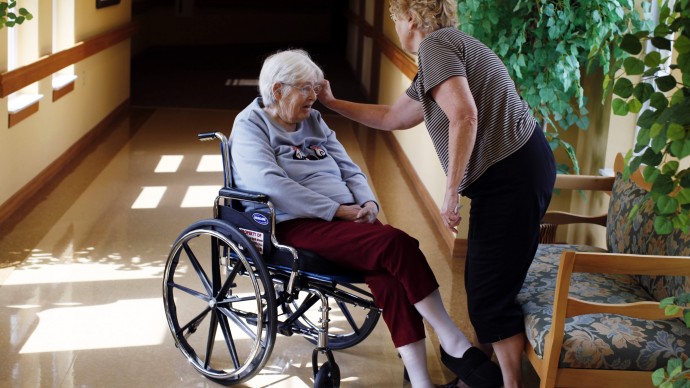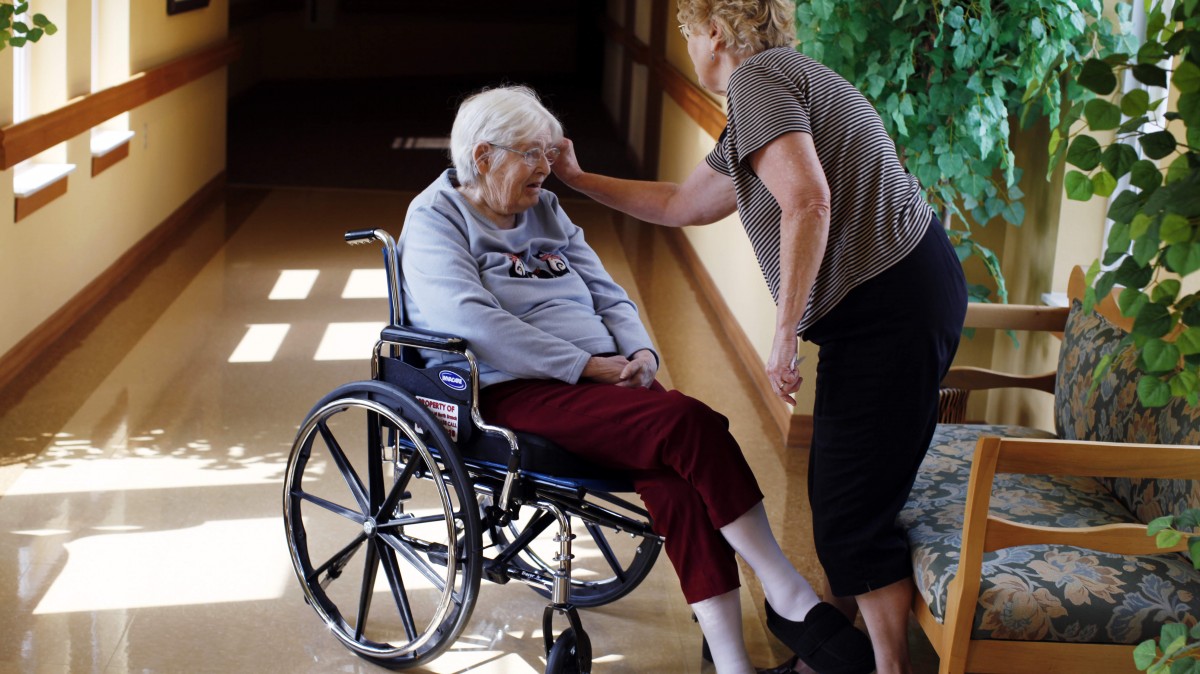
This story was produced in collaboration with the Washington Post.
After nearly two years in a Baltimore nursing home, Sonia Savage was eager to leave. She was in her late 20s, surrounded by older people and feeling “it wasn’t a place for me.”
Savage had suffered a traumatic brain injury, a stroke and broken bones after being struck by a car in 2009 while crossing the street with her 7-year-old daughter, who died after the crash. Now 30 years old, she still uses a wheelchair and walker but is in her own house, outfitted for the handicapped. “It was a new beginning,” said Savage.
Savage is one of 1,336 disabled or elderly low-income Marylanders who as of early July had moved out of nursing homes and other institutional settings as part of a national program called Money Follows the Person. The goal is to return them to the community.
Maryland’s program is doing well compared with efforts in most of the 43 participating states and the District, having already moved 55 percent of its original target of 2,413. But the same is not true for the District and Virginia, where there are fewer stories like Sonia Savage’s. As of July 2, only 126 people had moved in the District, just 11 percent of its original five-year goal of 1,110. In Virginia, where the latest figures are from May, 362 people had moved, 35 percent of the original goal of 1,041.
Many states have fallen far short of early, optimistic projections. Five years into the program, about 22,500 people nationwide have left institutional settings and transitioned back into community settings. The states’ goal had been 35,380, a target that federal officials now say was unrealistic.
Officials at the Centers for Medicare & Medicaid Services, which administers the program, concede that it got off to a slow start. They say that many states had to create community- and home-based care systems from scratch. Some ran up against a shortage of home health workers, which many participants need. Some did not anticipate the bureaucratic challenges, such as negotiating contracts with local nonprofits to help with transitions.
Congress has authorized $4 billion for the program through September 2016. To date, the federal government has paid or committed to pay $1 billion to the states, most of which set up their programs by the end of 2008. Maryland was awarded up to $67.1 million for the first five years; Virginia, $28.6 million; and the District, $26.3 million. None has received all the allotted money, as there have been fewer participants than expected.
Money Follows the Person covers the elderly, adults with physical disabilities, the developmentally disabled and the mentally ill. Participants must choose to return to the community and be enrolled in Medicaid, the state-federal program for the poor and disabled. Transition coordinators assist them with moving into apartments, houses, small group homes or, in some cases, assisted living facilities.
The federal government gives states additional Medicaid money to help with each person’s transition over the first 12 months.
This includes paying for home- and community-based services, security deposits and renovations to make housing handicap-accessible.
In subsequent years, states are expected to use Medicaid money to keep paying for the person’s home health, personal care and other services, although there is no formal requirement that the states do so.
The program also requires states to spend some of the Medicaid money they’ve gotten for the program on long-term-care services that will help people live in their own homes. The goal is to avoid institutionalizing people in the first place.
Each state has flexibility in deciding whether to focus on a particular group.
In the District, 101 participants are developmentally disabled people who had been living in institutions. As of July, only 25 nursing home residents had transitioned out since the program started in 2008.
In December 2010, disability rights advocates filed a class-action lawsuit against the District, claiming that it had deprived 2,900 Medicaid-covered nursing home residents of their right to return to the community. In February, a judge rejected the District’s request to throw out the case.
“We’re in Year 5 of a five-year Money Follows the Person grant, and they’ve barely transitioned anyone from a nursing home,” said Marjorie Rifkin, managing attorney for University Legal Services, a nonprofit advocacy group that co-filed the lawsuit. “The District made no effort to market the program. People in nursing homes don’t know the services exist, and to a large degree the staff don’t know, either.”
Leyla Sarigol, Money Follows the Person project director at the District’s Department of Health Care Finance, defended the program, saying officials initially chose to focus on the developmentally disabled because the infrastructure was already there for them in the community.
Sarigol said her office began its “pilot work” in nursing homes only in 2010 and acknowledged that it has faced barriers finding subsidized housing and primary-care doctors for Medicaid patients with complex medical needs. Sarigol said that 40 nursing home residents were supposed to be chosen in a lottery in July for Money Follows the Person slots and that those who are relocated would continue to receive home health and community services after the first year is over. But as of mid-September, the lottery still had not been held.
Curtis Wilkerson, now 49, tried for years to get into the District’s program. He suffered a spinal cord injury from a surgery that left him a paraplegic and for more than a decade he lived in nursing homes.
The former sous-chef wanted to live in his own home, though, and thought if he could get help with everyday activities he would be able to manage. In 2009, he contacted the District’s Money Follows the Person program and was told it was closed. Two years later, he said, a program outreach worker visited him and he applied. In August, Wilkerson was notified he had been accepted. Since then, he said, he has received little help.
On his own, he signed up with the District’s housing authority and got one of its handicap-accessible apartments, a one-bedroom unit in a brand-new complex in Southeast. He left the nursing home and moved in earlier this month.
Wilkerson remains frustrated with the program. Other than buying him furniture, “they’ve hardly done anything,” said Wilkerson, who is a plaintiff in the lawsuit against the District. “They didn’t pay for my first month’s rent or security, which I ended up paying myself. They haven’t paid the rent for October; I’m paying for that. They didn’t find a home health care agency to take care of me.
“It’s ridiculous.”
In Virginia, which likewise launched its program in 2008, officials also have run up against obstacles.
“Housing is the top challenge we face,” said Nichole Martin, long-term-care program manager at Virginia’s Department of Medical Assistance Services. “When we started out, we didn’t know how much of a challenge it would be.”
As in the District, the bulk of Virginia’s participants have been developmentally disabled people in institutions. As of the end of May, only 135 elderly people or adults with physical disabilities had left nursing homes.
Terry Smith, the department’s director of long-term care, said more developmentally disabled people have transitioned out because their need is greater. At least 7,000 are on waiting lists for home- and community-based services.
But advocates say there’s also a need for nursing home residents to move back to the community and that Virginia has not done a good enough job signing up people for the program.
“We’re not sure if it’s not being followed through on, if folks aren’t being encouraged enough or whether there’s some disconnect,” said Joani Latimer, Virginia’s ombudsman for long-term care. (In addition to Latimer, Virginia has local ombudsmen in offices around the state.) “The ombudsmen have their antennae up when they work with residents who have an interest, but it’s hard to know why there aren’t more folks surfacing.”
In Maryland, 87 percent of Money Follows the Person participants have come from nursing homes. Devon Snider, the program’s director at the Maryland Department of Health and Mental Hygiene, said “finding affordable, accessible housing is definitely an issue.”
While Maryland’s number of transitions is among the highest in the country, advocates say not enough people have been helped.
“It’s completely insufficient,” said Gayle Hafner, senior attorney for the Maryland Disability Law Center. “It’s been five years. There’s been all this money coming in and yet the transition rate has stagnated.”
Sonia Savage, the Baltimore woman who finally left her nursing home, said the program turned around her life.
Savage is living with her two children in a three-bedroom rowhouse in East Baltimore that the landlord made handicap-accessible to accommodate her. She has signed up for job training and hopes to return to secretarial work.
“Now that I have a home, everything has changed,” she said. “The program has made me feel like I have a life again.”
This story was originally published by Kaiser Health News.


